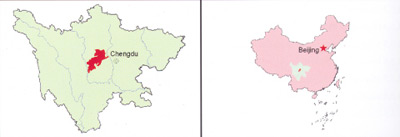Sichuan Giant Panda Sanctuaries -- Wolong, Mt. Siguniang and Jiajin Mountains
Sichuan Giant Panda Sanctuaries, home to more than 30 percent of the world's highly endangered pandas, covers 924,500 hectares with seven nature reserves and nine scenic parks in the Qionglai and Jiajin Mountains, between the Chengdu Plateau and the Qinghai-Tibet Plateau.
 |
The sanctuaries constitute the largest remaining contiguous habitat of the giant panda, which is recognized as a “national treasure” of China and is a flagship for global conservation efforts. This species is a relict from the paleo-tropic forests of the Tertiary Era. The giant panda feeds almost exclusively on bamboo in the wild and its preferred habitat is between 2,200m to 3,200m.
 |
As a unique single species and family the giant panda is very important for studying mammal classification and evolution. Within the sanctuaries, the main centers of giant panda population are in the Wolong Reserve in the northeast; Fengtongzhai Reserve in the southeast; and in Jiajin Mountain Provincial Park to the southwest. There is also the species' most important site for captive breeding.
 |
The regions are among the botanically richest sites of any region in the world, outside the tropical rain forests, with between 5,000 and 6,000 species of flora in over 1,000 genera. 50 genera are endemic to China (20 percent of its total) and 67 plant species are nationally protected. The reasons for this diversity include the wide range of different habitat types afforded by the large altitudinal range, sharp climatic gradation, the variety of rock and soil types and the wide and complex connections with other major floristic regions.
 |
 |
On July 12, 2006, the site was inscribed on the World Heritage List as a natural property at the 30th session of the UNESCO's World Heritage Committee held in Vilnius, capital of Lithuania.
 |
 |
Administration Office of the Wolong Giant Panda Sanctuaries
Tel: 0837-6246773
(China.org.cn, July 15, 2006)
 0
0 






